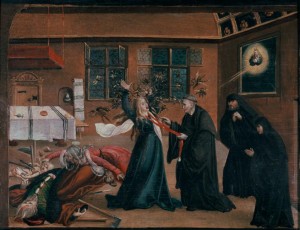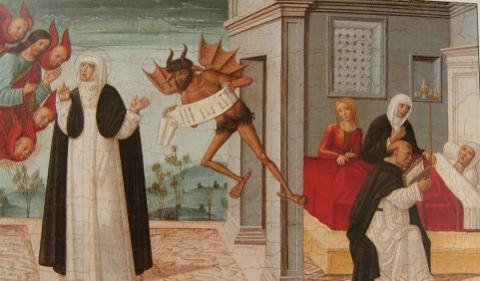Descriptions of common men and women convulsing violently, speaking in tongues, expelling foreign objects like nails and pins, and levitating above their beds seem ripped out of the pages of a bestselling horror novel, or the plot to a (hopeful) blockbuster movie. But, in fact, medieval church records from the 16th and 17th century recount hundreds of cases like these, in which the afflicted was reported to be possessed by a demon or the Devil himself. In this supernatural-themed episode (just in time for Halloween!), guest Brian Levack talks about his latest book The Devil Within: Possessions and Exorcism in the Christian West, and his research into the deeper social causes and meanings of these alleged “demonic possessions” in early modern Europe.
Guests
 Brian LevackJohn E. Green Regents Professor in History and Distinguished Teaching Professor at the University of Texas at Austin
Brian LevackJohn E. Green Regents Professor in History and Distinguished Teaching Professor at the University of Texas at Austin
Hosts
 Joan NeubergerProfessor of History, University of Texas at Austin
Joan NeubergerProfessor of History, University of Texas at Austin
Today we are going to be talking about a new book that our guest just published entitled The Devil Within: Possessions and Exorcism in the Christian West. So lets start with demonic possession, what are we talking about?
Well, we are talking actually about a belief that certain things happened, but it is a belief that the devil–Satan–or one of his subordinate demons, entered into the body of a human being and controlled that person’s physical movements and also their mental faculties. There were various signs or symptoms of this invasion, because it really is an invasion against the person’s will. The person would usually have violent convulsions. Their limbs would become rigid, so much so that their legs could not be uncrossed, even when people try to pull them apart. They would vomit alien objects like nails and pins and stones and this type of thing. And sometimes they would levitate, or at least these are all reports.
You have to understand, we have narratives that they actually engaged in these activities. Then there were what we might call more verbal or linguistic symptoms of this invasion. And the main one is that they would start speaking in languages of which they had no previous knowledge, or they would speak in a very, very, unnatural deep voice, which was interpreted as being the devil’s voice. Or they would show contempt for sacred objects and they would blaspheme. Sometimes they went into trances, they would foretell the future. So, in other words, it’s a whole constellation of these symptoms. They didn’t all exhibit the same ones, but those are the most common ones of what we call the “classic cases” of possession.
These things all seem very bizarre to us, although they seemed more natural at the time because people believed in possession. Today a lot of people have looked back and assumed that there was some kind of medical disorder, or mental disorder. What do you think about that?
I am not a believer, so I do not believe in the devil, and I don’t believe that the devil or any spirit can enter into a human being. But the important thing is that the society I study—and I’m mainly concerned with the 16th and 17th centuries—those people almost all believed in the devil, and a great majority of them believed that the devil could enter into human bodies and control their movements and their mental faculties. For those people, demonic possession made sense; it was perfectly understandable.
But there were people then, and there certainly are people today, who would look at this type of behavior and say that “Well, even though I believe in the devil, I don’t believe this behavior is the result of that type of invasion.” And they would be the people who would say that the symptoms of possession were the product of some kind of physical or mental illness. You get these people all the way back in the 16th and 17th century, but then especially in the Age of Reason and the 19th century and the 20th century, especially among doctors and psychiatrists. This is the universal explanation of all of these cases of possession.
What I am trying to do in the book is to show that those explanations might have some place in understanding this really bizarre behavior. I mean, people did engage in this bizarre behavior, maybe they were putting it on, maybe they were faking it, there were all sorts of explanations based on that. Sometimes the reports of this activity were exaggerated. But even the people who are skeptical are saying “Yeah, this person is acting in this really strange way, and their convulsing, we can’t uncross their legs, and what have you.”
What I am trying to do is show that those medical or natural explanations of possession cannot account for all of the symptoms, and especially those symptoms that we might refer to as verbal or linguistic or which had a religious dimension to them. But what I try to do is to explain this bizarre behavior by showing that it is rooted in the religious beliefs, and the religious culture in which these people lived.
So I’m restoring religious belief to this explanation.
So if the behavior is rooted in belief, but it is not necessarily provoked by some disorder, how do you explain what they are doing?
What I argue, is that all of these people are in a certain sense actors. They’re not consciously acting—some of them are, some of them are deliberately fraudulent, they are faking their possessions so that they can get sympathy, or they can get money, or they can accuse someone of having caused the possession and therefore be accused of witchcraft—but most of them are unconscious actors and they are involved in what I refer to as a sacred drama. And the argument of the book is that they are all following scripts that are—I use the word “encoded”—in their religious cultures.
They read about, or have read about, other possessions, or they have heard sermons about them. Because this is the time when there are lots and lots of possessions, I mean you have all of these pamphlets that are being written about them, or they may have heard about possessions that took place in their community or a distant community. Sometimes you have group possessions; you have close knit communities like convents especially, and orphanages, and small villages in which many people get possessed, and the symptoms seem to spread almost like an epidemic disease, that’s what it looks like.
Throughout the community and in those cases people have direct experience with other people supposedly being possessed, and that is how they learn these particular scripts. In other words, they learn how demoniacs are supposed to act and they act accordingly. They follow the script even thought they might not be doing it consciously. Nevertheless, they have that in their minds, and all of that comes out of this religious culture. I argue that you can’t fully explain this—I don’t know if we can ever explain the bizarre behavior—but you can’t fully explain it without understanding the theatrical, or what people would call performative, aspect of possessions.
So there were differences between Catholic and Protestant possession. Could you tell us a little about the differences?
Really, what you could say is that the scripts these demoniacs are following are very, very, different. Some of the purposes of the book is to say that you just don’t have one single type of possession, but that you have very different ones, and they divide pretty much along Catholic and Protestant lines. And you see this not just in the symptoms that the demoniacs—that’s the word we use to identify these people—but also in the exorcisms, which of course are conducted by the priest and ministers of the different confessions. And one of the clearest indications is that demoniacs, because they’re supposedly possessed by the devil, and the devil is controlling their actions and their words, is that they blasphemed. So they are rejecting the current religion. So if you have a Catholic demoniac, that person is going to blaspheme against the main features of Catholic culture, and especially against holy objects. So you know, if you present the person with the holy Eucharist or something like that, and say ‘this is the body of Christ,’ the person is going to reject it and start going into convulsions, and fits, and what have you.
Whereas a Protestant didn’t accept the sacraments as such, but what is important for Protestants is the Bible, that’s the foundation of the Protestant faith. So what you get in Protestant possessions is these Protestant demoniacs going into fits if they hear the Bible, and sometimes they bring the Bible in and they take it and throw the Bible down. So that would be one reflection of this difference. Also, in the exorcism themselves, the Catholic priest would appeal to the saints and especially to the virgin Mary—and by the way even today in Catholic exorcisms the main appeal is for the virgin Mary to help out, in other words, to intercede for God.
But the Protestants say, they try to devalue the saints and the blessed virgin Mary, so that it’s only up to God. So we have to leave it completely to God, which means you can’t go through all these rituals, and pray to the saints, and to the blessed virgin Mary; you have to just pray and fast that’s the only thing you can do during a Protestant exorcism, and hope that God in his wisdom and his mercy is going to drive the spirit out. Of course, very often that didn’t happen in Protestant exorcisms.
So they were less successful than Catholic exorcisms?
Much less successful, and they admitted this. You have Protestants saying “why is it that the Catholic exorcisms are working, and the Protestant ones aren’t working?” Well, it has a lot to do with the assurance that the demoniac feels that something is being done, and when their pronouncing rituals, and their praying, and wrapping the stole around the person, then they feel, well, maybe the demon is being driven out. Because a lot of this is psychological, whereas if you’re just sitting there, waiting for God to come back, maybe that just doesn’t work.
That doesn’t work because it’s not that good of a script.
Exactly, it’s just not that effective. You can’t really do a statistical study because we just don’t have really hard evidence the way we do in witchcraft prosecutions about how many demoniacs there are. Based on the reports that we have, and we have hundreds of these cases of possession, and we have the sermons that relate other ones, there are at least ten to fifteen times more Catholic demoniacs than Protestant demoniacs.
And like witchcraft in Western Europe, were there more women or more men demoniacs?
Most people say that it’s fairly evenly divided. My selective research—and again, we have just small databases—is that, just as in witchcraft, an overwhelming majority of the demoniacs were females. But unlike witches, who tended to be old and very often widowed and excluded from the community and dependent upon the community, the Catholic demoniacs tended to be young women, very often nuns in the convents, and they experienced psychological problems very often connected with their sexuality, and the you don’t get that at all in the Protestants.
I kept looking for Protestants who were expressing their sexuality. No, the Protestants were disobeying their parents, or they were playing cards, or they were dancing, but there was no sex there and that’s because Protestant culture was concerned with a whole range of sinful activities. Some of these are very minor activities. But the thing is that Protestants generally don’t distinguish between mortal sins and venial sins; they don’t have a hierarchy of sins, whereas the Catholics do. And right at the top of it is sexual sins. That is why you get sexuality in many of these Catholic possessions.
Aside from the social and individual gender issues, this was a period when religious institutions were undergoing major transformations and major conflict. Does that explain why there were so many possessions during this period? Were they somehow reacting against the changes in the church? How does that play out?
I think especially in the Catholic communities they were determined to stem the tide of Protestantism by staging possessions, or especially exorcisms, which they said would prove that the Catholic church was the one true church. And the way they did that was to display the holy Eucharist, you know, the Holy Communion, and if the exorcist could drive out the devil by displaying the host. That would prove that Christ was really present, and that, therefore, the Huguenots or the Calvinists in France were a part of a false religion. So the exorcisms become a mode of propaganda.
Now you could also say that just the religious culture of the Early Modern period, because it was characterized by this conflict between Catholicism and Protestantism, that all of that involved a heightened consciousness of the devil, and therefore people are thinking of the devil. That is why communities, when they saw people having fits or convulsions, which is usually the way it started, they would say it’s the devil, because they know the devil is around.
A lot of people are thinking it’s the time of the apocalypse and that the Anti-Christ is appearing, and, of course, the devil is especially active, and–this is especially true of the Protestants. You read all of these treatises in which they talk about the fact that these are the Last Days. They are getting ready for the Second Coming, the Last Judgment, the rule of Christ probably for one thousand years, and millenarianism. They argued that the incidence of possession is going to increase, and they go back to scriptures, and of course, they also go back to the period of Christ. That was the first coming, and that was the first time the apocalypse was written. There are all of these quotes, especially in Revelations, about the devil being active at this time.
So it has a lot to do with both the reason why communities would think these people are possessed, and more important, would explain why the ministers both Catholic and Protestant would see these possessions as a sign of this apocalyptic expectation, this eschatology as we would call it. So I think that has a lot to do with why you get so many cases at this time.
And do you have a sense of why they began to die out after the 17th century?
I think basically people begin to lose faith in it—they don’t necessarily abandon their beliefs in spirits, although some of them do. I mean, you enter into what we call the Age of Reason, and this is not true for most of the people, but its certainly true for the educated elites. So even within the clergy, you have people saying “well, there might be spirits, but they certainly can’t intervene in nature, or in the people’s lives.” And of course you end up getting Deists, who say there are no spirits, either good or bad, nor God can intervene in the normal operation of the laws of nature. So I think that even though you have cases that might have turned into cases of possession, you have the ministers who will look at this and say “Well, that’s not a case of possession, because we know that the devil doesn’t do this anymore.”
So they’re rejecting the whole script really, the whole drama, so interesting.
Exactly.
And you write at the end of the book that, other than the 16th and 17th, it’s really the late 20th and 21st century where we see bizarrely a rise in possession.
It’s coming back! These rare cases, and this has a lot to do with a group of very active celebrity exorcists, especially in Italy where one of the exorcists has performed 70,000 exorcisms. There is one in Latin America whose done something similar to that. The other place is Poland, where there are a lot of exorcisms. But I argue that yes, there is the revival of this, and of course we have movies, but there’s a difference because I still do not see the type of classic possessions that I have described. You don’t get these people vomiting pins.
—or eels—
Right, eels or chamber pots. They really go overboard with this, a person vomiting 24 gallons of blood every day. Of course not! Well, the person had stomach problems and probably spit up a little bit of blood and that’s how it got exaggerated. But you don’t get that, basically it seems that there are people with minor medical problems or minor psychological problems, and the exorcist drums up business and says ‘I can help you.’ And that’s why you get literally thousands of these cases, but it’s just not the same as the Early Modern period.

